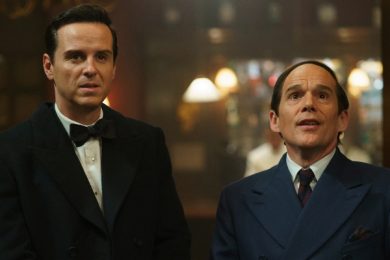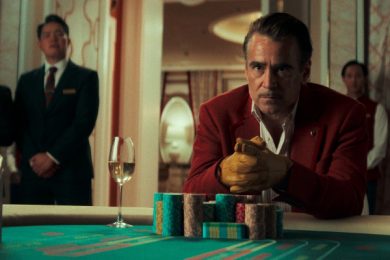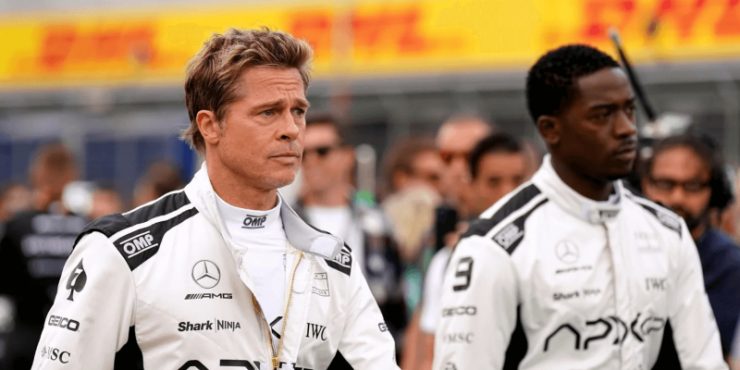It’s 2025 and Hollywood is opening two major Summer films starring Tom Cruise and Brad Pitt, respectively. It’s a testament to the two men’s longevity in this business, but it’s also a snapshot of the state of today’s big movies: is there anyone under the age of 50 looking to take this mantle? In the case of Cruise, here’s an actor who still shows incredible commitment physically, who pushes himself and performs acts that couldn’t be performed by a non-professional. On the other hand, Pitt stays in shape, stays ready, but he’s an old school type, who recognizes his first gear is better than most people’s third. The brilliance of his Oscar-winning role in Once Upon a Time in… Hollywood is that Tarantino took that reputation and revealed a sociopath hiding in plain sight – our hero is maybe more dangerous than the villain feared all this time.
This is a long way of saying that Cruise functions like a filmmaker, while Brad Pitt is still very filmmaker dependent. A director will bend to Cruise’s will, and that will usually make the movie better. If the same thing happens in a Pitt vehicle, the results are uneven. Director Joseph Kosinski worked with Cruise on Top Gun: Maverick, an unqualified success across the board, and often credited with resurrecting post-COVID box office. Cruise (rightfully) got most of the credit, but Maverick is a very well-directed movie. F1 is Kosinski’s follow-up, and for his star, he’s moving from one 90’s icon to another. Sure, F1 doesn’t have the benefit of being the sequel to another massively successful film like Maverick, but F1 is the first major studio film about the racing sport since its sudden burst in popularity in the last few years. There’s a desperation all over this movie, like they’re trying to get away with dramatizing something they’re supposed to understand but don’t.
It wouldn’t matter how well they understand it if the movie is good, but that’s not how modern-day studios work. Thanks in part to a Netflix reality show, F1 racing has climbed the ranks amongst the most popular sports in the world, led by driving stars like Max Verstappen and Lewis Hamilton (who is listed as a producer on this film). Also listed as producer is Jerry Bruckheimer, yet another 90s legend whose stellar producing run 3 decades ago is unlikely to ever be replicated. The Bruckheimer films always fulfilled the promise of entertainment for the audience, but they often lacked compelling narratives or interesting characters. A Bruckheimer movie (Con Air, Armageddon, The Rock, to name a few) is a pretty simple formula: a big, starry name at the top of the poster, a half-dozen undeniable action set pieces, a single woman (usually quite young, always very conventionally attractive) to fall in love with the starry name, and the rest is incidental. The story is a necessary but humorless patchwork to get you to the fast cars and big explosions.
This is how you end up with the kind of Hollywood movies that are too well-made to truly discount, but so anonymously told that they quickly become forgotten. F1 exists in this quality purgatory. You can’t argue with the racing scenes, where Kosinski brings the same propulsive, visceral energy to driver’s seat that he did to the cockpit in Maverick, but everything that surrounds it is empty. Worse than that, it becomes a commercial for a sport that may have already peaked as a novelty craze. When you recognize how flat the script is – stitched together with overused tropes that even the most nascent filmgoer will predict the plot beats that lie ahead – you end up astonished at how the film can still manage to be over two-and-a-half hours long. How can that be? All that space is filled simply explaining (and re-explaining) the complicated rules of this eccentric sport.
I’m not that naive, I recognized from the film’s first teaser that F1 was a cross-marketing opportunity writ large, and I don’t begrudge Kosinski or Paramount Pictures for trying to mine the material, but this is some pretty cynical work at times. Racing sports are orgies of product sponsorship, and so is F1: The Movie (as it’s being marketed), which never misses an opportunity to flash a product logo, whether it be for a Nutri-Ninja blender or the business start-up Expensify. That the movie is co-produced by Apple – one of the world’s wealthiest companies – doesn’t soothe any annoyance at the tactic. This is what we get instead of a story that would actually be compelling or characters that you would actually care about. The whole point of a sports movie is to have someone to root for.
What is the story? Brad Pitt plays Sonny Hayes, a race driving phenom who washed out after a dangerous accident. He’s spent three decades living out of his van, acting like a mercenary, picking up races where he can, often surprising people with his speed, and shocking people with his recklessness. He reunites with an old friend, Ruben Cervantes (Javier Bardem), who convinces him to join his floundering F1 team, APXGP, which is in last place and in danger of insolvency. Ruben needs a fast, experienced driver to help guide his team, including his rookie driver, Joshua Pearce (Damson Idris), whose skill has not yet reached the level of his raw talent. Sonny agrees to join, even though his enigmatic nature keeps the audience in the dark as to how much emotional investment he actually has.
Sonny and Joshua don’t mix. The young driver doesn’t care for Sonny’s abrupt, tactless forms of wisdom; while the veteran doesn’t much appreciate the rookie’s dependence on technology and social media self-promotion. Straight out of Rocky IV, F1 often contrasts Joshua’s twenty-first century tools against Sonny’s analog basics. Joshua has a digital wall to test his hand-eye coordination, Sonny bounces rubber balls, etc. Another problem for APXGP is the car, which lacks the structure and build to win a professional race. Its designer, Kate McKenna (Kerry Condon), is searching for ways to make the APXGP car faster, but she can’t figure it out. Sonny’s decades of experience finally gives Kate someone who can diagnose the car’s problems, and help the team go from last place to contender.
In the end, all that matters are the racing scenes. To the film’s credit, they still manage to be very exciting despite the APXGP team rarely challenging for anything near first place. There’s a byzantine nature to the sport, a point-collection process that I failed to grasp, despite the movie’s many explanations. The truth is that I didn’t care because F1 can’t find a way to explain the rules outside of having an overhead commentator explain them over and over. In the end, the cars go at incredibly dangerous speeds, and Kosinski is able to convey that even for a car that is floundering in last place. The slight presentation of a Formula One car (say versus a Nascar stock car), makes that danger even more prevalent. The mortality rate for F1 drivers is insanely high for a professional sport. F1 never raises the stakes that high (after all, it is selling the sport to you), but it makes the danger feel real.
This all comes back to Pitt, the film’s star and producer, who’s made no secret that he wishes this film to be his Maverick – ie, a late career triumph that eats up box office while re-establishing him as a bonafide, blockbuster-opening star. But Pitt is not the movie star auteur that Cruise is. Cruise’s insane ego almost always will serve the movie, where Pitt’s ego often tends to serve him. If there isn’t a proper enough director to keep him in place, Pitt’s self-interest will always take center stage. Kosinski allows Pitt to drag Sonny Hayes into a place the star feels most comfortable: unknowability. Sonny is the selfless specter who vanishes just moments after his impact is most felt. It’s a trick that lets Pitt off the hook from creating anything profound, and stops him from doing actual acting. Perhaps the fear is that spending any extended time with a BradPitt character will reveal a homicidal Cliff Booth. The role of Booth won him an Oscar partly because it revealed a dark truth, but Pitt doesn’t seem interested in exploring that a second time.
Directed by Joseph Kosinski










